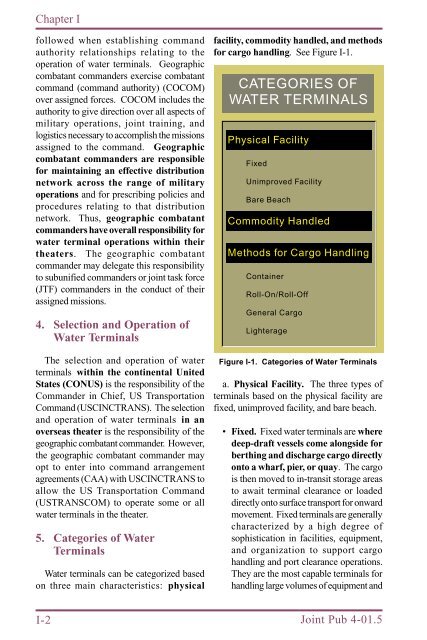JP 4-01.5 JTTP for Water Terminal Operations - BITS
JP 4-01.5 JTTP for Water Terminal Operations - BITS
JP 4-01.5 JTTP for Water Terminal Operations - BITS
You also want an ePaper? Increase the reach of your titles
YUMPU automatically turns print PDFs into web optimized ePapers that Google loves.
Chapter I<br />
followed when establishing command<br />
authority relationships relating to the<br />
operation of water terminals. Geographic<br />
combatant commanders exercise combatant<br />
command (command authority) (COCOM)<br />
over assigned <strong>for</strong>ces. COCOM includes the<br />
authority to give direction over all aspects of<br />
military operations, joint training, and<br />
logistics necessary to accomplish the missions<br />
assigned to the command. Geographic<br />
combatant commanders are responsible<br />
<strong>for</strong> maintaining an effective distribution<br />
network across the range of military<br />
operations and <strong>for</strong> prescribing policies and<br />
procedures relating to that distribution<br />
network. Thus, geographic combatant<br />
commanders have overall responsibility <strong>for</strong><br />
water terminal operations within their<br />
theaters. The geographic combatant<br />
commander may delegate this responsibility<br />
to subunified commanders or joint task <strong>for</strong>ce<br />
(JTF) commanders in the conduct of their<br />
assigned missions.<br />
4. Selection and Operation of<br />
<strong>Water</strong> <strong>Terminal</strong>s<br />
The selection and operation of water<br />
terminals within the continental United<br />
States (CONUS) is the responsibility of the<br />
Commander in Chief, US Transportation<br />
Command (USCINCTRANS). The selection<br />
and operation of water terminals in an<br />
overseas theater is the responsibility of the<br />
geographic combatant commander. However,<br />
the geographic combatant commander may<br />
opt to enter into command arrangement<br />
agreements (CAA) with USCINCTRANS to<br />
allow the US Transportation Command<br />
(USTRANSCOM) to operate some or all<br />
water terminals in the theater.<br />
5. Categories of <strong>Water</strong><br />
<strong>Terminal</strong>s<br />
<strong>Water</strong> terminals can be categorized based<br />
on three main characteristics: physical<br />
I-2<br />
facility, commodity handled, and methods<br />
<strong>for</strong> cargo handling. See Figure I-1.<br />
CATEGORIES OF<br />
WATER TERMINALS<br />
Physical Facility<br />
Fixed<br />
Unimproved Facility<br />
Bare Beach<br />
Commodities<br />
Commodity Handled<br />
Methods <strong>for</strong> Cargo Handling<br />
Container<br />
Roll-On/Roll-Off<br />
General Cargo<br />
Lighterage<br />
Figure I-1. Categories of <strong>Water</strong> <strong>Terminal</strong>s<br />
a. Physical Facility. The three types of<br />
terminals based on the physical facility are<br />
fixed, unimproved facility, and bare beach.<br />
• Fixed. Fixed water terminals are where<br />
deep-draft vessels come alongside <strong>for</strong><br />
berthing and discharge cargo directly<br />
onto a wharf, pier, or quay. The cargo<br />
is then moved to in-transit storage areas<br />
to await terminal clearance or loaded<br />
directly onto surface transport <strong>for</strong> onward<br />
movement. Fixed terminals are generally<br />
characterized by a high degree of<br />
sophistication in facilities, equipment,<br />
and organization to support cargo<br />
handling and port clearance operations.<br />
They are the most capable terminals <strong>for</strong><br />
handling large volumes of equipment and<br />
Joint Pub 4-<strong>01.5</strong>
















